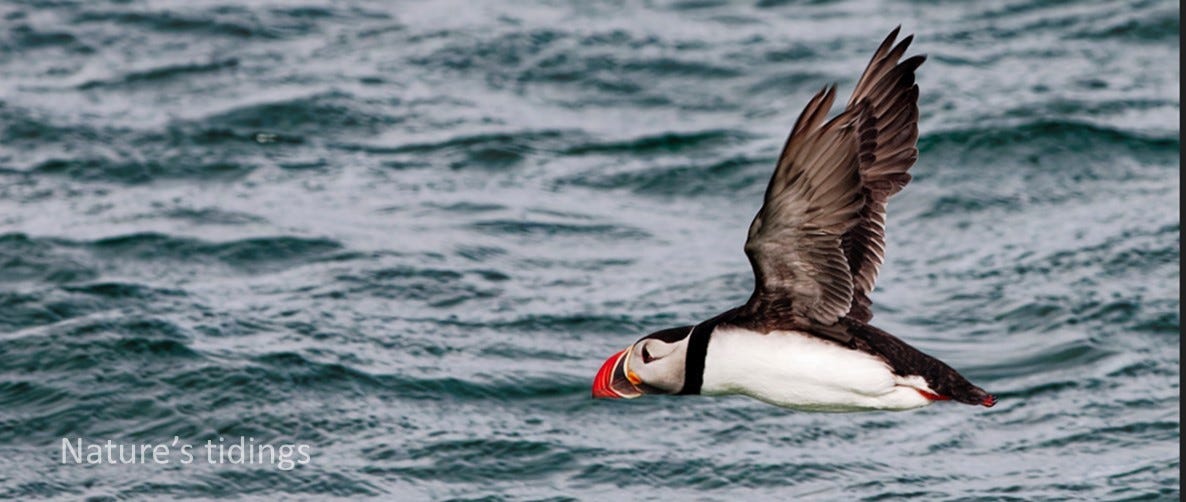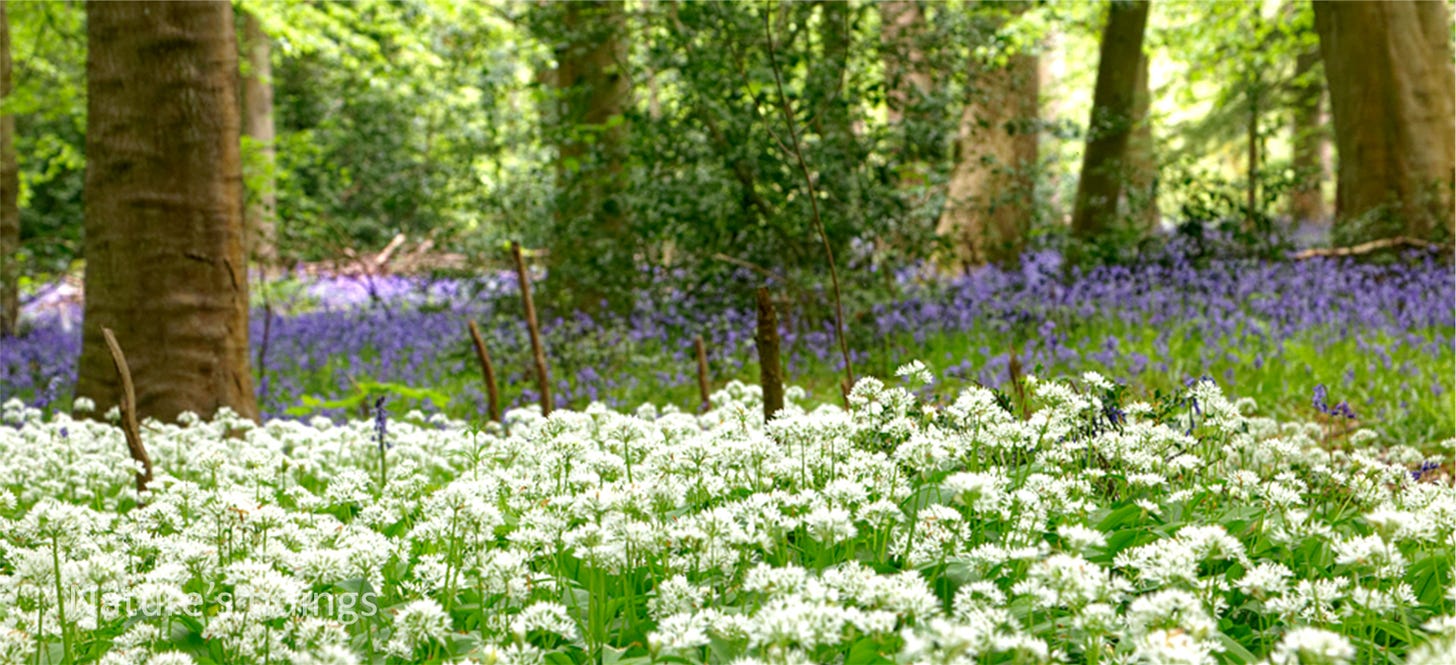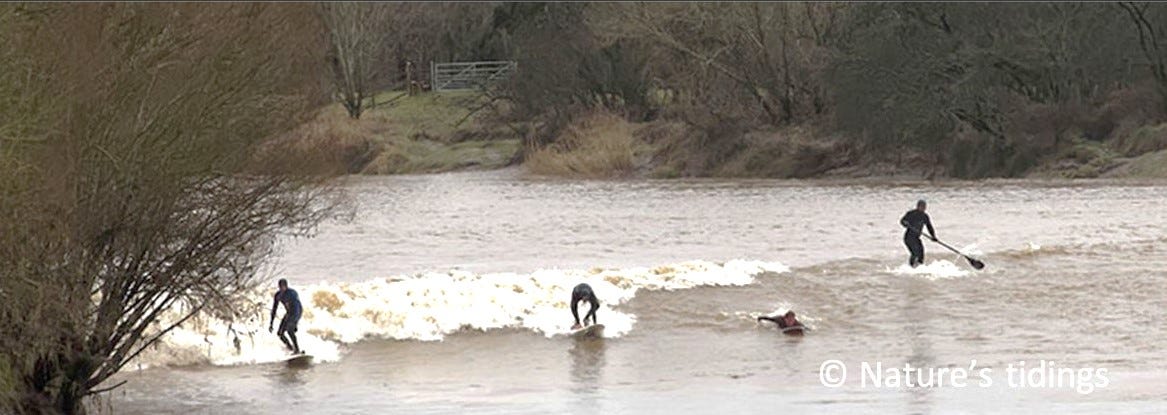Welcome to the May issue of Nature’s tidings with news of seabirds, wildflowers and tidal bores.
It’s now prime seabird viewing season including the diminutive puffin which typically nests between April and July, spending the rest of the time at sea. With its distinctive and slightly comical-looking bill, it’s one of the most easily recognizable birds, but sometimes surprisingly difficult to spot amongst the many gannets, kittiwakes and guillemots that frequent our shores.
Part of the reason is that its ideal nesting grounds are earth burrows within easy reach of cliffs and the sea, making remote islands a favoured spot. That means that, while you may see some floating on the water or guarding cliff tops during a boat trip, for the best views you really need to land. However, to avoid disturbance there are very few places where this is allowed.
If you are interested in making a sighting, search online for RSPB, National Trust and other destinations that permit landings, for which start points include places in Northumberland, Pembrokeshire, Northern Ireland and Scotland. Further afield, perhaps the most popular destination in the USA is along the northeast coast in Maine.
A puffin off the coast of Northumberland in April 2025
On a recent trip to Northumberland’s Farne Islands, thousands had already arrived, with many guarding the burrows they had already selected to raise their pufflings – the name for a puffin chick of which each pair of adults raises just one a year. The National Trust volunteers who manage the site estimate that more than 40,000 pairs arrive in some years.
Wildflowers are another feature at this time of year and the bluebell season is already in full swing. This is one of the UK’s most iconic wildflowers and about half of those worldwide are said to grow here. With attractive drooping indigo-blue flowers, the native type is not to be confused with the paler, more upright Spanish bluebell, which is a non-native species that has escaped into the wild.
The Woodland Trust’s Nature’s Calendar site suggests that first flowering had occurred in most places by the end of April, with the Trust also suggesting that this has typically occurred 1-2 weeks earlier than usual this year due to the prolonged sunny weather in recent weeks. So if you are interested in a sighting it’s best to be quick as they are already fading in places. The Woodland Trust website is a good starting point for ideas for places to visit if you don’t already have a favoured spot, and check social media too for the latest reports of sightings (#bluebells).
Bluebells and another fine woodland sight (and smell) in spring: wild garlic
Internationally, of course, there are many more species of wildflower to see and in his book Wildflower Wonders: the fifty best wildflower sights in the world botanist Bob Gibbons’ suggestions include mountain sites in Greece, France, Spain, Switzerland and Italy and in Washington State, California, Oregon and Colorado in the USA.
Experts surfing the Severn Bore
While the highest tides of spring may have recently passed, looking ahead to the next high tides of autumn I’m pleased to say that with fellow enthusiast Rob Bridges we had the following scientific paper on tidal bores published last month:
Estuarine and Hydraulic Characteristics for Twenty Two Tidal Bores in England, Scotland and Wales
This was in Estuaries and Coasts which is the journal of the Coastal and Estuarine Research Federation. Hope you find it interesting.
We decided to write this after realizing just how common they are in the UK but how little information was available except for the best known such as the Severn Bore, Trent Aegir and Arnside Bore. Eventually, from our own observations, online sightings and theoretical concepts we were able to piece together some key characteristics for twenty two on a common basis. These included the mean heights, mean speeds and distances covered and the types and intertidal areas of the estuaries in which they occur.
To our surprise, we found that they happen in roughly 10-20% of UK estuaries from Somerset to south Wales, north Wales to the Solway Firth, and the Humber Estuary to the Wash. Internationally, they also make up a significant proportion of those worldwide, where perhaps the most popular with spectators are those in southwest France, eastern China, southeast India, east Sumatra and around the Bay of Fundy.
Thinking back to when my own interest started, this was on a cycling trip alongside the Solway Firth in north Cumbria, when much to my surprise I spotted an impressive line of surf heading inland. Some online research showed this to be the little-known Solway Bore, which got me wondering how many others there were around the UK, beyond the few I’d heard of already. I decided to see more and to share my interest too, writing blog posts about them and an ebook for beginners new to tidal bore watching. And as so often happens if you follow your interests, it’s led to all kinds of other interests too, such as in estuary wildlife and maritime history.
Rob’s journey also began with a surprisingly impressive sighting and his chosen path to sharing information is a video channel which now features an impressive number of recordings, proving a great help in pooling our information on sightings. However, as we’ve both found photographs and videos alone don’t fully show the sound and power of the spectacle and to really experience this you need to see a large tidal bore for yourself.
As he said in Spectacular Britain ‘To me, tidal bores are a mesmerising natural phenomenon to witness and have a rare beauty of their own’ as well as providing the following useful advice that ‘For a good chance of seeing one, choose a day when a high spring tide is expected, with a low or normal river level and no or little wind. Get to the viewing location at least forty minutes before the bore is expected to arrive and remember, estuaries can be exposed places so wrap up if necessary. Always keep safety in mind and steer clear of quicksand, mud and saltmarsh.’
You’ll find more safety advice for estuaries and the Severn Bore on the RNLI website and that of the Gloucester Harbour Trustees (which is useful for other tidal bores too).
Further reading
Nature’s Calendar, Woodland Trust, https://naturescalendar.woodlandtrust.org.uk/
Spectacular Britain: A spotter’s guide to the UK’s most amazing natural phenomena, by Kevin Sene, Bloomsbury for scientific insights and more tips on spotting seabirds, wildlflowers and tidal bores.
Videos of tidal bores by Rob Bridges, Youtube channel
Tidal bores of England, Scotland and Wales, by Kevin Sene, Troubador, ebook
Wildflower Wonders: the fifty best wildflower sights in the world, by Bob Gibbons, Bloomsbury








I didn't realise that the Solway had a bore! That's good to know. (We visit that part of Scotland quite often)
Do any east coast estuaries, such as the Firth of Tay, have tidal bores? I tend to associate them with southwest facing inlets.
This week I was also writing about how early the bluebells and other spring indicators are: https://open.substack.com/pub/felicitymartin/p/spring-is-bursting-out-all-over?r=dsete&utm_medium=ios